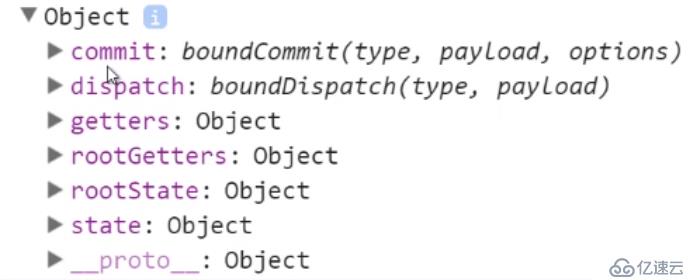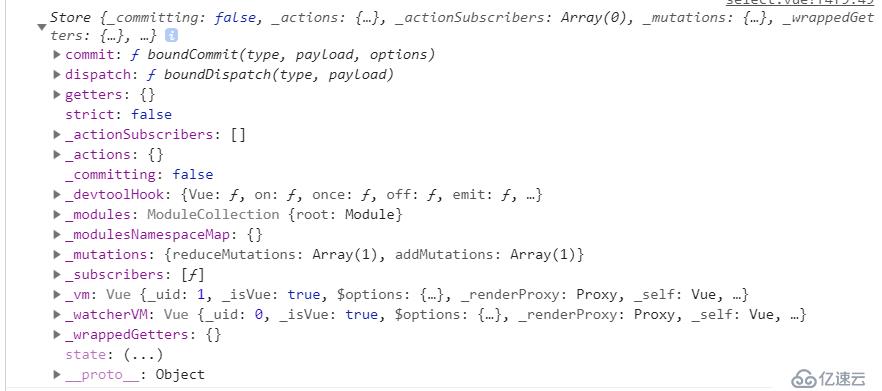жӮЁеҘҪпјҢзҷ»еҪ•еҗҺжүҚиғҪдёӢи®ўеҚ•е“ҰпјҒ
дёҖгҖҒжҰӮи§Ҳ
1гҖҒVuexжҳҜд»Җд№Ҳ
дәҢгҖҒVuexж ёеҝғжҰӮеҝө
1гҖҒstoreпјҡзұ»дјје®№еҷЁпјҢеҢ…еҗ«еә”з”Ёзҡ„еӨ§йғЁеҲҶзҠ¶жҖҒ
дёүгҖҒдҪҝз”ЁVuex
1гҖҒе®үиЈ…VuexжЁЎеқ—
npm install vuex --save
2гҖҒдҪңдёәжҸ’件дҪҝз”Ё
import Vue from 'vue'
import Vuex from 'vuex'
Vue.use(Vuex)
3гҖҒе®ҡд№үе®№еҷЁ
let store = new Vuex.Store({
state:{
count:100
},
mutations:{ //еҜ№иұЎпјҢйҮҢйқўжҳҜеҗ„з§Қжӣҙж”№stateзҠ¶жҖҒеҖјзҡ„еҮҪж•°пјҢеҗҢжӯҘз«ӢеҚіжӣҙж”№зҠ¶жҖҒ
add( state,payload ){ //еҸӮж•°stateе°ұжҳҜдёҠйқўзҡ„stateпјҢpayloadжҳҜиҰҒдј йҖ’зҡ„еҖј
state.count+=payload.n;
}
},
actions:{ //ејӮжӯҘжӣҙж”№зҠ¶жҖҒпјҢеҸҜд»ҘжҳҜajaxиҜ·жұӮжҲҗеҠҹд№ӢеҗҺж”№еҸҳзҠ¶жҖҒпјҢиҝҷйҮҢз”Ёе®ҡж—¶еҷЁжЁЎжӢҹпјҢ1з§’й’ҹд№ӢеҗҺжҸҗдәӨmutationsж”№еҸҳзҠ¶жҖҒ
//ејӮжӯҘзҡ„жӣҙж”№зҠ¶жҖҒжҳҜзӣҙжҺҘеңЁindex.jsйҮҢйқўзҡ„actionsйҮҢйқўе®ҡд№үaction然еҗҺcommitзҡ„(йҷ„еёҰеҸӮж•°)пјҢиҖҢдёҚжҳҜеңЁз»„件еҶ…жҸҗдәӨпјҢжіЁж„ҸеҢәеҲ«пјҢејӮжӯҘжҳҜеңЁз»„件еҶ…dispatchиҝҷдёӘactions(actionsйҮҢйқўе·Із»ҸеҢ…еҗ«дәҶmutations)пјҢеҗҢжӯҘжҳҜеңЁз»„件еҶ…commitиҝҷдёӘmutations(йҷ„еёҰеҸӮж•°)
//ејӮжӯҘд№ҹеҸҜд»ҘеңЁindex.jsйҮҢйқўзӣҙжҺҘdispatchиҝҷдёӘactions(йҷ„еёҰеҸӮж•°)пјҢеңЁз¬¬дёҖдёӘajaxйҮҢйқўжҺҘзқҖиҜ·жұӮ第дәҢдёӘajax
addAction( context ){ //ajax1
setTimeout(function(){
context.commit('add',{n:200}); //иҝҷйҮҢз”Ёзҡ„mutationsиҝҳжҳҜдёҠйқўе®ҡд№үзҡ„add
context.dispatch('textAction',{test:'жөӢиҜ•'}) //и§ҰеҸ‘ajax2
},1000)
}
textAction( context,obj ){ //ajax2
console.log(obj)
}
//еҲ©з”Ёes6и§Јжһ„иөӢеҖјж”№еҶҷдёҠйқўзҡ„д»Јз ҒпјҢеӣ дёәcontextеҜ№иұЎдёӢйқўжңүcommitе’Ңdispatchж–№жі•
addAction( {commit,dispatch} ){
setTimeout(function(){
commit('add',{n:200}); //зӣҙжҺҘеҸҜд»ҘиҺ·еҸ–еҲ°commitж–№жі•пјҢдёҚз”ЁжҳҜcontext.commit
dispatch('textAction',{test:'жөӢиҜ•'})
},1000)
}
textAction( context,obj ){ //ajax2
console.log(obj)
}
},//ејӮжӯҘжӣҙж”№зҠ¶жҖҒ,дёҖж®өж—¶й—ҙд№ӢеҗҺеҶҚж”№еҸҳзҠ¶жҖҒпјҢеҸӘиҰҒжҳҜејӮжӯҘзҡ„ж”№еҸҳйғҪеҶҷеңЁactionsйҮҢйқў
getters:{ //зұ»дјји®Ўз®—еұһжҖ§пјҢеҜ№зҠ¶жҖҒеҒҡиҝӣдёҖжӯҘзҡ„еӨ„зҗҶ
filterCount(state){
return state.count>=120?120:state.count++;
}
}
})
export default store
4гҖҒжіЁе…Ҙж №е®һдҫӢ
import store from './store'
new Vue({
store
})5гҖҒеңЁstateйҮҢйқўе®ҡд№үзҡ„жҳҜзҠ¶жҖҒпјҢеҰӮжһңеңЁз»„件еҶ…йғЁиҰҒдҪҝз”ЁиҝҷдёӘзҠ¶жҖҒпјҢйӮЈд№ҲдёҖиҲ¬еңЁз»„件еҶ…йғЁйҖҡиҝҮи®Ўз®—еұһжҖ§жқҘеҫ—еҲ°е®ғ
<button @click="addHandle()"></button>
<p>{{count}}</p>
<p>{{count2}}</p>
computed:{
count(){
return this.$store.state.count
},
count2(){
return this.$store.getters.filterCount //иў«gettersиҝӣдёҖжӯҘеӨ„зҗҶиҝҮзҡ„зҠ¶жҖҒ
}
},
methods:{
addHandle(){ //иҰҒеҠЁжҖҒзҡ„ж”№еҸҳзҠ¶жҖҒпјҢе°ұйңҖиҰҒжҳҫзӨәзҡ„жҸҗдәӨдёҖдёӘmutations вҖ”> add
//еҗҢжӯҘпјҢеҶҷжі•дёҖ
this.$store.commit('add',{n:10})
//еҗҢжӯҘпјҢеҶҷжі•дәҢ
this.$store.commit({
type:'add',
n:5
})
//ејӮжӯҘпјҢеҶҷжі•
this.$store.dispatch('addAction')
}
}6гҖҒcontextжҳҜдёҖдёӘеҜ№иұЎпјҢдёҚжҳҜstateе®һдҫӢ
7гҖҒдҪҝз”Ёиҫ…еҠ©еҮҪж•°
import {mapState,mapGetters,mapActions,mapMutations} from 'vuex'
//иҝҷжҳҜж”№еҶҷstateе’Ңgetters
computed:{
num(){
return this.$store.state.count
},
num2(){
return this.$store.getters.filterNum
}
}
computed:mapState({
num:state => state.count
num:'count'
num(state){
return state.count+100
}
count:'count' //жӯӨж—¶жёІжҹ“зҡ„жҳҜcountпјҢдёҚжҳҜnum
})
computed:{
abc(){
return 123
},
...mapGetters({
num2:'filterCount' //еҰӮжһңkeyеҖјпјҲеҚіиҰҒжёІжҹ“еҲ°йЎөйқўзҡ„еҸҳйҮҸеҖјпјүе’ҢvuexйҮҢйқўе®ҡд№үзҡ„жҳҜдёҖж ·зҡ„пјҢйӮЈд№Ҳе°ұеҸҜд»ҘжҳҜдёӢйқўйӮЈз§ҚеҶҷжі•
}),
...mapState(['count']) //count:count countжҳҜиҰҒжёІжҹ“еҲ°йЎөйқў state:{count:100}пјҢstateйҮҢйқўе®ҡд№үзҡ„зҠ¶жҖҒеҗҚд№ҹжҳҜcount
}
//иҝҷжҳҜж”№еҶҷactionsе’Ңmutations
methods:{
add(){ //ејӮжӯҘactions
this.$store.dispatch('addAction')
}
},
reduce(){ //жҷ®йҖҡmutationsпјҢеҸӮж•°еҸҜд»ҘзӣҙжҺҘи·ҹеңЁеҜ№иұЎйҮҢ
this.$store.commit({
type:'reduceMutation',
n:10
})
}
methods:{
...mapActions({
add:'addAction' //addжҳҜйЎөйқўзӮ№еҮ»еҮҪж•°пјҢaddActionжҳҜvuexйҮҢйқўе®ҡд№үзҡ„action
})
...mapMutations({ //иҝҷз§Қж–№жі•иҰҒдј еҸӮпјҢеҸӘиғҪжҳҜеңЁи°ғз”Ёзҡ„ж—¶еҖҷдј иҝӣеҺ»
reduce:'reduceMutation'
})
}
<input type="button" value="-" @click="reduce({n:10})"> еҸӮж•°еңЁиҝҷйҮҢдј пјҢе’Ңжҷ®йҖҡеҶҷжі•дёҚеҗҢ
еӣӣгҖҒжЎҲдҫӢ
**index.js**
let store = new Vuex.Store({
state:{ //еҜ№иұЎпјҢеә”з”ЁжүҖйңҖиҰҒзҡ„зҠ¶жҖҒж•°жҚ®йғҪж”ҫеңЁиҝҷйҮҢйқў
count:100
},
mutations:{ //еҜ№иұЎпјҢжҳҫзӨәзҡ„еҗҢжӯҘжҸҗдәӨmutationsпјҢзҠ¶жҖҒжҳҜзӮ№еҮ»д№ӢеҗҺз«ӢеҚіж”№еҸҳ
addIncrement(state,payload){ //иҝҷйҮҢжҳҜиҮӘе®ҡд№үaddIncrementдәӢ件
state.count+ = payload.n
}
},
actions:{ //ејӮжӯҘзҡ„ж”№еҸҳзҠ¶жҖҒпјҢжҜ”еҰӮеҸ‘йҖҒиҜ·жұӮжҲҗеҠҹд№ӢеҗҺжүҚж”№еҸҳзҠ¶жҖҒпјҢдёҚжҳҜеҚіж—¶зҡ„ж”№еҸҳ
addAction( context ){ //иҝҷйҮҢж–°еҠ иҮӘе®ҡд№үдәӢ件addAction
setTimeout( ()=>{ /жЁЎжӢҹејӮжӯҘж“ҚдҪң
//ж”№еҸҳзҠ¶жҖҒпјҢжҸҗдәӨmutationsпјҢд»Қ然жҳҜдёҠйқўmutationsйҮҢйқўе®ҡд№үзҡ„дәӢ件addIncrement
context.commit('addIncrement',{n:15})
context.dispatch('textAction',{test:'жөӢиҜ•'}) //иҝҷйҮҢжү§иЎҢиҜҘејӮжӯҘж“ҚдҪң
},1000 )
},
textAction(context,obj){ //е®ҡд№ү第дәҢдёӘејӮжӯҘж“ҚдҪң
console.log(obj) //{test:'жөӢиҜ•'}
},
getListAction( context ){ //иҝҷйҮҢе®ҡд№үдәҶејӮжӯҘжҺҘеҸЈactionпјҢеңЁеӯҗ组件createdйҮҢйқўи°ғз”Ё
axios.get('url')
.then( (data)=>{
console.log(data); //еҫ—еҲ°дәҶжҺҘеҸЈж•°жҚ®
} )
}
},
getters:{ //еҜ№storeйҮҢйқўзҡ„ж•°еҖјиҝӣиЎҢйҖ»иҫ‘ж“ҚдҪң
filterState(state){
return state.count>=120?120:state.count
}
}
})
export default store
**increment组件пјҡ**
<template>
<p>{{num}}</p>
<span>{{filterNewNum}}</span>
<input type="button" value="+" @click="addHandle" />
</template>
<script>
computed:{
num(){
rerurn this.$store.state.count //жҺҘ收еҺҹе§ӢзҠ¶жҖҒеҖј
},
filterNewNum(){ //иҝҷйҮҢйқўжҺҘ收иҝҮж»ӨеҗҺзҡ„пјҢд»“еә“йҮҢйқўзҡ„ж•°жҚ®
return this.$store.getters.filterState //жіЁж„ҸжҳҜreturnпјҢдёҚиҰҒжјҸдәҶ
}
},
methods:{
addHandle(){ //ж”№еҸҳзҠ¶жҖҒпјҢжҸҗдәӨдёҖдёӘmutations
this.$store.commit('addIncrement',{ //иҝҷйҮҢжҳҜcommit addIncrement
n:5 //еҸӮж•°
});
}
//иҝҷйҮҢжҳҜејӮжӯҘи§ҰеҸ‘дёҖдёӘactionпјҢжіЁж„Ҹе’ҢдёҠйқўеҗҢжӯҘзҡ„дёҚеҗҢд№ӢеӨ„
this.$store.dispatch('addAction') //иҝҷйҮҢжҳҜdispatch addAction
},
created(){
this.$store.dispatch('getListAction'); //dispatch
}
д№ҹеҸҜд»Ҙиҝҷж ·еҶҷпјҡ
methods:{
addHandle(){
this.$store.commit({
type:'addIncrement', //ж”№еҸҳзҡ„зҠ¶жҖҒзұ»еһӢ
n:5 //еҸӮж•°
})
}
}
</script>
//дёҠйқўжҳҜеҗҢжӯҘж“ҚдҪңж•°жҚ®пјҢдҪҝз”ЁmutationsпјҢеҰӮжһңиҰҒејӮжӯҘж“ҚдҪңж•°жҚ®пјҢе°ұз”ЁеҲ°ActionsпјҢжіЁж„ҸпјҢдёҚз®ЎжҳҜеҗҢжӯҘиҝҳжҳҜејӮжӯҘж“ҚдҪңпјҢж”№еҸҳж•°жҚ®еүҚйғҪеҫ—е…ҲжҸҗдәӨmutations
//еҗ‘еҗҺз«ҜеҸ‘йҖҒajaxиҜ·жұӮе°ұж”ҫеңЁActionsйҮҢйқўгҖӮеңЁmethodsйҮҢйқўеҲӣе»әж–№жі•пјҢйҖҡиҝҮaxiosиҺ·еҸ–ж•°жҚ®пјҢ然еҗҺжӣҙж–°еҲ°storeйҮҢйқўе®ҡд№үзҡ„еҸҳйҮҸпјҢиҝҷдёҖзі»еҲ—ж“ҚдҪңйғҪеңЁindex.jsж–Ү件йҮҢйқўе®ҢжҲҗ
еҰӮжһңиҰҒеҜ№storeйҮҢйқўзҡ„ж•°еҖјиҝӣиЎҢйҖ»иҫ‘еҲӨж–ӯпјҲж•°жҚ®иҝҮж»ӨгҖҒж•°жҚ®зҡ„еҠ еҮҸд№ҳйҷӨпјүпјҢйӮЈд№Ҳе°ұз”ЁеҲ°gettersпјҢз”Ёжі•зұ»дјјдәҺи®Ўз®—еұһжҖ§computedпјҢgettersеҸҜд»ҘзңӢеҒҡжҳҜVuexзҡ„и®Ўз®—еұһжҖ§
еңЁStoreд»“еә“йҮҢпјҢstateе°ұжҳҜз”ЁжқҘеӯҳж”ҫж•°жҚ®пјҢеңЁVueйҮҢйқўиӢҘжҳҜеҜ№ж•°жҚ®иҝӣиЎҢеӨ„зҗҶиҫ“еҮәпјҢжҜ”еҰӮж•°жҚ®иҰҒиҝҮж»ӨпјҢдёҖиҲ¬жҲ‘们еҸҜд»ҘеҶҷеҲ°computedдёӯгҖӮдҪҶжҳҜеҰӮжһңеҫҲеӨҡ组件йғҪдҪҝз”ЁиҝҷдёӘиҝҮж»ӨеҗҺзҡ„ж•°жҚ®пјҢжҜ”еҰӮйҘјзҠ¶еӣҫ组件е’ҢжӣІзәҝеӣҫ组件пјҢжҲ‘们жҳҜеҗҰеҸҜд»ҘжҠҠиҝҷдёӘж•°жҚ®жҠҪжҸҗеҮәжқҘе…ұдә«пјҹиҝҷе°ұжҳҜgettersеӯҳеңЁзҡ„ж„Ҹд№үгҖӮжҲ‘们еҸҜд»Ҙи®ӨдёәпјҢгҖҗgettersгҖ‘жҳҜstoreзҡ„и®Ўз®—еұһжҖ§гҖӮеӣ дёәgettersжҳҜеҜ№ж•°жҚ®иҝӣиЎҢйҖ»иҫ‘иҝҗз®—пјҢиҖҢдёҚжҳҜж–°ж·»еҠ зҡ„ж–№жі•жҲ–еҠҹиғҪпјҢд»…д»…жҳҜжҳҜж•°жҚ®зҡ„йҖ»иҫ‘иҝҗз®—пјҢжүҖд»ҘиҰҒе§Ӣз»Ҳиҝ”еӣһдёҖдёӘж–°еҖјпјҢеҸҜд»Ҙе…ҲеңЁgettersдёӢйқўзҡ„ж–№жі•йҮҢйқўе®ҡд№үдёҖдёӘж–°еҖјеҸҳйҮҸпјҢз»ҸиҝҮи®Ўз®—пјҢ然еҗҺreturnеҮәиҝҷдёӘж–°еҸҳйҮҸ
дә”гҖҒVuexиҫ…еҠ©еҮҪж•°
дҪҝз”Ёиҝҷдәӣиҫ…еҠ©еҮҪж•°пјҢйҰ–е…ҲйңҖиҰҒеј•е…ҘvuexпјҢиҝҷдәӣйғҪжҳҜvuexдёӢйқўзҡ„ж–№жі•пјҢдҪҝз”Ёи§Јжһ„иөӢеҖј
import { mapState } from 'vuex'
mapState
mapGetters
mapMutations
mapActions
ж”№еҶҷдёҠйқўзҡ„д»Јз Ғпјҡ
Increment.vue组件
<template>
<p>{{count}}</p>
<span>{{filterNum}}</span>
<input type="button" value="+" @click="add" />
<input type="button" value="-" @click="reduce({n:11})"/>
</template>
<script>
import {mapState,mapGetters,mapActions,mapMutations} from 'vuex'
export default {
data(){
},
computed:{
abc(){
return 123 //жҷ®йҖҡзҡ„и®Ўз®—еұһжҖ§
},
...mapState(['count']) //иҝҷйҮҢзҡ„countе°ұжҳҜstoreйҮҢйқўе®ҡд№үзҡ„д»“еә“йҮҢйқўзҡ„count
...mapGeters(['filterNum']) //д»ҺgettersйҮҢйқўеҸ–еҖј(з»ҸиҝҮйҖ»иҫ‘еӨ„зҗҶзҡ„еҖј)
},
methods:{
/*reduce(){ //еҗҢжӯҘи§ҰеҸ‘action
this.$store.commit('reduceAction',{n:5}) //еҗҢжӯҘжҜҸж¬ЎеҮҸ5
}*/
...mapMutations({ //ж”№еҶҷmutationsпјҢиҰҒдј еҸӮпјҢеҸӮж•°еңЁжЁЎжқҝйҮҢйқўж·»еҠ reduce({n:11})
reduce:'reduceAction'
})
/*add(){ //ејӮжӯҘи§ҰеҸ‘actions
this.$store.dispatch('addAction')
}*/
...mapActions({ //ж”№еҶҷactions
add:'addAction'
})
}
}
</script>
index.js
import Vue from 'vue'
import Vuex from 'vuex'
Vue.use(Vuex)
let store = new Vuex.Store({
state:{
count:100
},
mutations:{
addHandle(state,payload){ //payloadжҳҜеҸӮж•°
state.count+=payload.n;
},
reduceAction(state,payload){
state.count-=payload.n
}
},
actions:{
addAction(context){
setTimeout(()=>{
context.commit('addHandle',{n:15}) //ејӮжӯҘжҜҸж¬ЎеҠ 15
},1000)
}
},
getters:{
filterNum(state){
return state.count>=102?102:state.count
}
}
})
export default storeе…ӯгҖҒеңЁvue-cliйҮҢйқўдҪҝз”ЁVuex
1гҖҒnpm install vuex --save
2гҖҒеңЁsrcзӣ®еҪ•дёӢйқўж–°е»әstoreж–Ү件еӨ№пјҢйҮҢйқўж–°е»әindex.js
3гҖҒstore/index.jsд»Јз Ғпјҡ
import Vue from 'vue'
import Vuex from 'vuex'
import axios from 'axios'
Vue.use(Vuex)
let store = new Vuex.Store({
state:{
shopCarData:[] //иҙӯзү©иҪҰзҡ„ж•°жҚ®й»ҳи®Өж•°жҚ®ж јејҸжҳҜж•°з»„пјҢдҪҝз”ЁVuexеҜ№иҝҷдёӘж•°з»„иҝӣиЎҢж“ҚдҪң
},
mutations:{
addShopCarData(state,data){
//do something
}
},
getters:{
}
})
export default store4гҖҒmain.jsд»Јз Ғ
import store from './store'
new Vue({
el:'#app',
router,
store,
template:'<App/>',
components:{
App
}
})дёғгҖҒvuexдҪҝз”Ёеҝғеҫ—1гҖҒеңЁstateйҮҢйқўе®ҡд№үе…ЁеұҖе…ұз”Ёзҡ„зҠ¶жҖҒж•°жҚ®пјҢstateжҳҜдёҖдёӘеҜ№иұЎпјҢйҮҢйқўе®ҡд№үй”®еҖјеҜ№пјҢеңЁз»„件йЎөйқўпјҢиҺ·еҸ–stateзҠ¶жҖҒеҖјпјҢйҖҡиҝҮcomputedи®Ўз®—еұһжҖ§жқҘиҺ·еҸ–
2гҖҒеҚіж—¶дҝ®ж”№stateзҠ¶жҖҒеҖјпјҢйҖҡиҝҮжҸҗдәӨmutationsжқҘиҝӣиЎҢпјҢmutationsжҳҜдёҖдёӘеҜ№иұЎпјҢйҮҢйқўе®ҡд№үеҗ„з§Қдҝ®ж”№stateзҠ¶жҖҒеҖјзҡ„ж–№жі•пјҢж–№жі•жҺҘ收stateе’ҢpayloadдёӨдёӘеҸӮж•°
3гҖҒејӮжӯҘдҝ®ж”№stateзҠ¶жҖҒеҖјпјҢйҖҡиҝҮactionsжқҘиҺ·еҸ–ж•°жҚ®пјҢ然еҗҺд№ҹиҰҒйҖҡиҝҮжҸҗдәӨmutationsжқҘдҝ®ж”№stateйҮҢйқўе®ҡд№үзҡ„зҠ¶жҖҒеҖј
з”Ёзҡ„иҫғеӨҡзҡ„жҳҜйҖҡиҝҮaxiosжқҘиҺ·еҸ–иҝңзЁӢж•°жҚ®пјҢ然еҗҺеңЁthenж–№жі•йҮҢйқўcommitдёҖдёӘmutationsжқҘдҝ®ж”№stateйҮҢйқўзҡ„еҺҹе§ӢзҠ¶жҖҒеҖјпјҢmutationsиҰҒе…Ҳе®ҡд№ү
еңЁcreated(){}йҮҢйқўйҖҡиҝҮthis.$store.dispatch('fetchDataAction')жқҘжү§иЎҢиҝҷдёӘactionsпјҢ
е®ҡд№ү@clickж–№жі•жқҘеҚіж—¶жҸҗдәӨmutationsпјҢ
br/>1гҖҒеңЁstateйҮҢйқўе®ҡд№үе…ЁеұҖе…ұз”Ёзҡ„зҠ¶жҖҒж•°жҚ®пјҢstateжҳҜдёҖдёӘеҜ№иұЎпјҢйҮҢйқўе®ҡд№үй”®еҖјеҜ№пјҢеңЁз»„件йЎөйқўпјҢиҺ·еҸ–stateзҠ¶жҖҒеҖјпјҢйҖҡиҝҮcomputedи®Ўз®—еұһжҖ§жқҘиҺ·еҸ–
2гҖҒеҚіж—¶дҝ®ж”№stateзҠ¶жҖҒеҖјпјҢйҖҡиҝҮжҸҗдәӨmutationsжқҘиҝӣиЎҢпјҢmutationsжҳҜдёҖдёӘеҜ№иұЎпјҢйҮҢйқўе®ҡд№үеҗ„з§Қдҝ®ж”№stateзҠ¶жҖҒеҖјзҡ„ж–№жі•пјҢж–№жі•жҺҘ收stateе’ҢpayloadдёӨдёӘеҸӮж•°
3гҖҒејӮжӯҘдҝ®ж”№stateзҠ¶жҖҒеҖјпјҢйҖҡиҝҮactionsжқҘиҺ·еҸ–ж•°жҚ®пјҢ然еҗҺд№ҹиҰҒйҖҡиҝҮжҸҗдәӨmutationsжқҘдҝ®ж”№stateйҮҢйқўе®ҡд№үзҡ„зҠ¶жҖҒеҖј
з”Ёзҡ„иҫғеӨҡзҡ„жҳҜйҖҡиҝҮaxiosжқҘиҺ·еҸ–иҝңзЁӢж•°жҚ®пјҢ然еҗҺеңЁthenж–№жі•йҮҢйқўcommitдёҖдёӘmutationsжқҘдҝ®ж”№stateйҮҢйқўзҡ„еҺҹе§ӢзҠ¶жҖҒеҖјпјҢmutationsиҰҒе…Ҳе®ҡд№ү
еңЁcreated(){}йҮҢйқўйҖҡиҝҮthis.$store.dispatch('fetchDataAction')жқҘжү§иЎҢиҝҷдёӘactionsпјҢ
е®ҡд№ү@clickж–№жі•жқҘеҚіж—¶жҸҗдәӨmutationsпјҢ
е…ҚиҙЈеЈ°жҳҺпјҡжң¬з«ҷеҸ‘еёғзҡ„еҶ…е®№пјҲеӣҫзүҮгҖҒи§Ҷйў‘е’Ңж–Үеӯ—пјүд»ҘеҺҹеҲӣгҖҒиҪ¬иҪҪе’ҢеҲҶдә«дёәдё»пјҢж–Үз« и§ӮзӮ№дёҚд»ЈиЎЁжң¬зҪ‘з«ҷз«ӢеңәпјҢеҰӮжһңж¶үеҸҠдҫөжқғиҜ·иҒ”зі»з«ҷй•ҝйӮ®з®ұпјҡis@yisu.comиҝӣиЎҢдёҫжҠҘпјҢ并жҸҗдҫӣзӣёе…іиҜҒжҚ®пјҢдёҖз»ҸжҹҘе®һпјҢе°Ҷз«ӢеҲ»еҲ йҷӨж¶үе«ҢдҫөжқғеҶ…е®№гҖӮ
жӮЁеҘҪпјҢзҷ»еҪ•еҗҺжүҚиғҪдёӢи®ўеҚ•е“ҰпјҒ